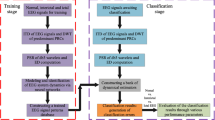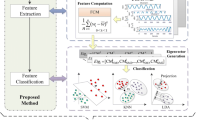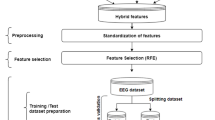Abstract
Epilepsy is a commonly observed long-term neurological disorder that impairs nerve cell activity in the brain and has a severe impact on people’s daily lives. Accurate seizure detection in the long-term electroencephalogram (EEG) signals has gained vital importance in the diagnosis of patients with epilepsy. Visual interpretation and detection of epileptic seizures in long-term EEG is a time-consuming and burdensome task for neurologists. Therefore, in this study, we propose a computationally efficient automated seizure detection model using a novel feature called successive decomposition index (SDI). We observed that the SDI feature was significantly higher during the epileptic seizure as compared to normal EEG. The performance of the proposed method was evaluated using three databases, namely the Ramaiah Medical College and Hospital (DB1), CHB-MIT (DB2) and the Temple University Hospital (DB3) consisting of 58 h, 884 h, and 408 h of EEG, respectively. Experimental results revealed the sensitivity–false detection rate–median detection delay of 97.53%–0.4/h–1.5 s, 97.28%–0.57/h–1.7 s, and 95.80%–0.49/h–1.5 s for DB1, DB2, and DB3, respectively, using the support vector machine classifier. The proposed method significantly outperformed previously presented methods (wavelets and other feature extraction methods) while being computationally more efficient. Further, to the best of the author’s knowledge, present study is the first study that was tested on three different EEG databases and showed consistent results leading to the generalization and robustness of the algorithm. Hence, the proposed method is an efficient tool for neurologists to detect epileptic seizures in long-term EEG.









Similar content being viewed by others
References
Aarabi A, Fazel-Rezai R, Aghakhani Y (2009) A fuzzy rule-based system for epileptic seizure detection in intracranial EEG. J Clinical Neurophysiololgy 120:1648–1657
Acharya UR, Molinari F, Sree SV, Chattopadhyay S, Ng KH, Suri JS (2012a) Automated diagnosis of epileptic EEG using entropies. Biomed Signal Process Control 7(4):401–408
Acharya UR, Sree SV, Alvin APC, Suri JS (2012b) Use of principal component analysis for automatic classification of epileptic EEG activities in wavelet framework. Expert Syst Appl 39(10):9072–9078
Acharya UR, Sree SV, Swapna G, Martis RJ, Suri JS (2013) Automated EEG analysis of epilepsy: a review. Knowl Based Syst 45:147–165
Acharya UR, Fujita H, Sudarshan VK, Bhat S, Koh JE (2015) Application of entropies for automated diagnosis of epilepsy using EEG signals: a review. Knowl Based Syst 88:85–96
Adeli H, Zhou Z, Dadmehr N (2003) Analysis of EEG records in an epileptic patient using wavelet transform. J Neurosci Methods 123(1):69–87
Andrzejak RG, Lehnertz K, Mormann F, Rieke C, David P, Elger CE (2001) Indications of nonlinear deterministic and finite-dimensional structures in time series of brain electrical activity: dependence on recording region and brain state. Phys Rev E 64:061907
BalaKrishnan M, Colditz P, Boashash B (2014) A multi-channel fusion based new-born seizure detection. J Biomed Sci Eng 7:533–545
Besio WG, Martinez-Juarez IE, Makeyev O, Gaitanis J, Blum AS, Fisher RS, Medvedev AV (2014) High-frequency oscillations recorded on the scalp of patients with epilepsy using tripolar concentric ring electrodes. IEEE J Transl Eng Health Med 2:1–11
Bhattacharyya A, Sharma M, Pachori RB, Sircar P, Acharya UR (2018) A novel approach for automated detection of focal EEG signals using empirical wavelet transform. Neural Comput Appl 29(8):47–57
Bhattacharyya S, Biswas A, Mukherjee J, Majumdar AK, Majumdar B, Mukherjee S, Singh AK (2011) Feature selection for automatic burst detection in neonatal electroencephalogram. IEEE J Emerg Sel Top Circuits Syst 1:469–479
Blume WT, Kaibara M (1999) Atlas of pediatric electroencephalography, 2nd edn. Lippincott-Raven, Philadelphia
Blumenfeld H (2012) Impaired consciousness in epilepsy. Lancet Neurol 11(9):814–826
Bogaarts G, Gommer ED, Hilkman DMW, van Kranen-Mastenbroek V, Reulen JPH (2016) Optimal training dataset composition for SVM-based, age-independent, automated epileptic seizure detection. Med Biol Eng Comput 54:1285–1293
Chen D, Wan S, Bao FS (2017) Epileptic focus localization using discrete wavelet transform based on interictal intracranial EEG. IEEE Trans Neural Syst Rehabil Eng 25:413–425
Cichocki A, Vorobyov S (2000) Application of ICA for automatic noise and interference cancellation in multisensory biomedical signals. In: Proceedings of second international workshop on ICA and BSS, pp 621–626
Delorme A, Makeig S (2004) EEGLAB: an open source toolbox for analysis of single-trial EEG dynamics including independent component analysis. J Neurosci Methods 134(1):9–21
Esbroeck AV, Smith L, Syed Z, Singh SP, Karam ZN (2015) Multi-task seizure detection: addressing intra-patient variation in seizure morphologies. Mach Learn 102:309–321
Fisher RS, Cross JH, French JA, Higurashi N, Hirsch E, Jansen FE et al (2017) Operational classification of seizure types by the international league against epilepsy: position paper of the ilae commission for classification and terminology. Epilepsia 58(4):522–530. https://doi.org/10.1111/epi.13670
Fujiwara K, Miyajima M, Yamakawa T, Abe E, Suzuki Y, Sawada Y, Kano M, Maehara T, Ohta K, Sasai-Sakuma T, Sasano T, Matsuura M, Matsushima E (2016) Epileptic seizure prediction based on multivariate statistical process control of heart rate variability features. IEEE Trans Biomed Eng 63(6):1321–1332
Geng D, Zhou W, Zhang Y, Geng S (2016) Epileptic seizure detection based on improved wavelet neural networks in long-term intracranial EEG. Biocybern Biomed Eng 36(2):375–384
Gotman J (1982) Automatic recognition of epileptic seizures in the EEG. Electroencephalogr Clin Neurophysiol 54:530–540
Greene B, Faul S, Marnane W, Lightbody G, Korotchikova I, Boylan G (2008) A comparison of quantitative EEG features for neonatal seizure detection. J Clin Neurophysiol 119(6):1248–61
Harville D (2001) Matrix algebra from a statisticians perspective. Springer, Berlin
Hopfengärtner R, Kasper B, Graf W, Gollwitzer S, Kreiselmeyer G, Stefan H (2014) Automatic seizure detection in long-term scalp EEG using an adaptive thresholding technique: a validation study for clinical routine. Clin Neurophysiol 125:1289–1290
Kecman V (2011) Learning and soft computing. MIT Press, Cambridge
Kelly K, Shiau D, Kern R (2010) Assessment of a scalp EEG-based automated seizure detection system. J Clin Neurophysiol 121(11):1832–1843
Ko DY (2017) Epileptiform discharges. https://emedicine.medscape.com/article/1138880-overview. Accessed 04 Feb 2018
Kumar Y, Dewal M, Anand R (2014) Epileptic seizures detection in EEG using DWT-based apen and artificial neural network. Signal Image Video Process 8:1323–1334
Li M, Chen W, Zhang T (2018) FuzzyEn-based features in FrFT-WPT domain for epileptic seizure detection. Neural Comput Appl. https://doi.org/10.1007/s00521-018-3621-z
Mammone N, Inuso G, La Foresta F, Versaci M, Morabito FC (2011) Clustering of entropy topography in epileptic electroencephalography. Neural Comput Appl 20(6):825–833
Minasyan G, Chatten J, Chatten M, Harner R (2010) Patient-specific early seizure detection from scalp electroencephalogram. J Clin Neurophysiol 27(3):163–78
Mirowski P, Madhavan D, LeCun Y, Kuzniecky R (2009) Classification of patterns of EEG synchronization for seizure prediction. Clin Neurophysiol 120(11):1927–1940
Obeid I, Picone J (2016) The temple university hospital EEG data corpus. Front Neurosci 10:196
Online (2016) Temple university EEG corpus. https://www.isip.piconepress.com/projects/tuh_eeg. Accessed 04 Feb 2018
Online, Sirven JI (2017) What is epilepsy? https://www.epilepsy.com/learn/about-epilepsy-basics/what-epilepsy. Accessed 01 Feb 2018
Pauri F, Pierelli F, Chatrian GE, Erdly WW (1992) Long-term EEG-video-audio monitoring: computer detection of focal EEG seizure patterns. Electroencephalogr Clin Neurophysiol 82(1):1–9
Pereira LAM, Papa JP, Coelho ALV, Lima CAM, Pereira DR, de Albuquerque VHC (2017) Automatic identification of epileptic EEG signals through binary magnetic optimization algorithms. Neural Comput Appl. https://doi.org/10.1007/s00521-017-3124-3
Pietrangelo A (2017) Everything you need to know about epilepsy. https://www.healthline.com/health/epilepsy. Accessed 14 Feb 2018
Pippa E, Zacharaki EI, Mporas I, Tsirka V, Richardson MP, Michael (2016) Improving classification of epileptic and non-epileptic EEG events by feature selection. Neurocomputing 171:576–585
Pravin Kumar S, Sriraam N, Benakop PG, Jinaga BC (2010) Entropies based detection of epileptic seizures with artificial neural network classifiers. Expert Syst Appl 37:3284–3291
Raghu S, Sriraam N (2017) Optimal configuration of multilayer perceptron neural network classifier for recognition of intracranial epileptic seizures. Expert Syst Appl 89:205–221
Raghu S, Sriraam N (2018) Classification of focal and non-focal EEG signals using neighborhood component analysis and machine learning algorithms. Expert Syst Appl 113:18–32
Raghu S, Sriraam N, Kumar GP (2015) Effect of wavelet packet log energy entropy on electroencephalogram (EEG) signals. Int J Biomed Clin Eng 4(1):32–43
Raghu S, Sriraam N, Kumar GP (2016) Classification of epileptic seizures using wavelet packet log energy and norm entropies with recurrent elman neural network classifier. Cognit Neurodyn 11:51–66
Raghu S, Sriraam N, Kumar GP, Hegde AS (2018) A novel approach for real time recognition of epileptic seizures using minimum variance modified fuzzy entropy. IEEE Trans Biomed Eng 65:262–2612
Raghu S, Sriraam N, Hegde AS, Kubben PL (2019a) A novel approach for classification of epileptic seizures using matrix determinant. Expert Syst Appl 127(1):323–341
Raghu S, Sriraam N, Temel Y, Rao SV, Hegde AS, Kubben PL (2019b) Performance evaluation of DWT based sigmoid entropy in time and frequency domains for automated detection of epileptic seizures using SVM classifier. Comput Biol Med 110:127–143
Sackellares J, Shiau D, Halford J, LaRoche S, Kelly K (2011) Quantitative EEG analysis for automated detection of nonconvulsive seizures in intensive care units. Epilepsy Behav 1:S69–S73
Salanova V, Witt T, Worth R, Henry T, Gross R, Nazzaro J et al (2015) Long-term efficacy and safety of thalamic stimulation for drug-resistant partial epilepsy. Neurology 84:1017–1025
Samiee K, Kiranyaz S, Gabbouj M, Saramäki T (2015) Long-term epileptic EEG classification via 2d mapping and textural features. Expert Syst Appl 42(20):7175–7185
Samiee K, Kovcs P, Gabbouj M (2017) Epileptic seizure detection in long-term EEG records using sparse rational decomposition and local gabor binary patterns feature extraction. Knowl Based Syst 118:228–240
Schachter SC, Sirven JI (2017) EEG. https://www.epilepsy.com/learn/diagnosis/eeg. Accessed: 01 Feb 2018
Sharma M, Dhere A, Pachori RB, Acharya UR (2017) An automatic detection of focal EEG signals using new class of time-frequency localized orthogonal wavelet filter banks. Knowl Based Syst 118:217–227
Shen CP, Liu ST, Zhou WZ, Lin FS, Lam AYY, Sung HY et al (2013) A physiology-based seizure detection system for multichannel EEG. PLOS ONE 8:1–9
Shiao H, Cherkassky V, Lee J, Veber B, Patterson EE, Brinkmann BH, Worrell GA (2017) SVM-based system for prediction of epileptic seizures from iEEG signal. IEEE Trans Biomed Eng 64(5):1011–1022
Shoeb A, Guttag J (2010) Application of machine learning to epileptic seizure detection. In: Proceedings of the 27th international conference on international conference on machine learning, ICML’10, pp 975–982
Shoeb A, Edwards H, Connolly J, Bourgeois B, Treves ST, Guttag J (2004) Patient-specific seizure onset detection. Epilepsy Behav 5(4):483–498
Siddiqui MK, Islam MZ, Kabir MA (2018) A novel quick seizure detection and localization through brain data mining on ecog dataset. Neural Comput Appl. https://doi.org/10.1007/s00521-018-3381-9
Srinivasan V, Eswaran C, Sriraam N (2005) Artificial neural network based epileptic detection using time-domain and frequency-domain features. J Med Syst 29:647–660
Srinivasan V, Eswaran C, Sriraam N (2007) Approximate entropy-based epileptic EEG detection using artificial neural networks. IEEE Trans Inf Technol Biomed 11:288–295
Sriraam N, Raghu S (2017) Classification of focal and non focal epileptic seizures using multi-features and SVM classifier. J Med Syst 41(10):160
Subasi A, Kevric J, Canbaz MA (2017) Epileptic seizure detection using hybrid machine learning methods. Neural Comput Appl 31:317
Tawfik NS, Youssef SM, Kholief M (2016) A hybrid automated detection of epileptic seizures in EEG records. Comput Electr Eng 53:177–190
Temko A, Thomas E, Marnane W, Lightbody G, Boylan G (2011) EEG-based neonatal seizure detection with support vector machines. Clin Neurophysiol 122:464–473
van Putten MJ, Kind T, Visser F, Lagerburg V (2005) Detecting temporal lobe seizures from scalp EEG recordings: a comparison of various features. Clin Neurophysiol 116(10):2480–2489
Wang D, Miao D, Xie C (2011) Best basis-based wavelet packet entropy feature extraction and hierarchical EEG classification for epileptic detection. Expert Syst Appl 38:14314–14320
Zandi AS, Javidan M, Dumont GA, Tafreshi R (2010) Automated real-time epileptic seizure detection in scalp EEG recordings using an algorithm based on wavelet packet transform. IEEE Trans Biomed Eng 57(7):1639–1651
Zhou P, Chan KCC (2018) Fuzzy feature extraction for multichannel EEG classification. IEEE Trans Cognit Dev Syst 10(2):267–279
Zhou W, Liu Y, Yuan Q, Li X (2013) Epileptic seizure detection using lacunarity and Bayesian linear discriminant analysis in intracranial EEG. IEEE Trans Biomed Eng 60(12):3375–3381
Acknowledgements
The authors are grateful to doctors of the Institute of Neuroscience, Ramaiah Medical College and Hospitals, Bengaluru, India, for valuable discussion and providing EEG recordings for research purpose. Authors also grateful to Dr. Ali Shoeb from CHB-MIT and team of the TUH for permitting to use their database for research. This research did not receive any specific grant from funding agencies in the public, commercial, or not-for-profit sectors.
Author information
Authors and Affiliations
Corresponding author
Ethics declarations
Conflict of Interest
The authors declare that there is no conflict of interest regarding the publication of this paper.
Ethical approval
The proper consent was taken from the ethics committee to use the RMCH database for research purpose. The proposed study makes use of two open source databases (DB2 and DB2), where appropriate ethical clearance has been already taken before database made available to public.
Additional information
Publisher's Note
Springer Nature remains neutral with regard to jurisdictional claims in published maps and institutional affiliations.
Appendices
Appendix 1
Figure 9a illustrates the EEG from DB2 (subject no:chb01) and Fig. 9b shows its image representation derived from SDI feature. An epileptic seizure activity begins at 327 s and ends at 420 s; Fig. 9b shows a significant increase of SDI during seizure activity. Similarly, Fig. 10a shows the epileptic EEG from DB3 (subject no.:1217, session:s03, and file:a02) and Fig. 10b presents an image representation of the corresponding SDI feature.
a Epileptic EEG example collected from DB2 which consist of 23 bipolar channels and display shows the EEG between the time duration of 300–500 s. b Image derived from SDI for the EEG as shown in Fig. 9a. The x-axis and y-axis represent time and channel, respectively. The colormap represents the SDI values (color figure online)
a Epileptic EEG example collected from DB3 which consist of 19 channels and EEG displayed between the time duration of 170–255 s. b Image derived from SDI for the EEG as shown in a. The x-axis and y-axis represent time and channel respectively. The colormap represents the SDI values (color figure online)
Appendix B
Table 8 shows the functions of MATLAB GUI components.
Rights and permissions
About this article
Cite this article
Raghu, S., Sriraam, N., Vasudeva Rao, S. et al. Automated detection of epileptic seizures using successive decomposition index and support vector machine classifier in long-term EEG. Neural Comput & Applic 32, 8965–8984 (2020). https://doi.org/10.1007/s00521-019-04389-1
Received:
Accepted:
Published:
Issue Date:
DOI: https://doi.org/10.1007/s00521-019-04389-1






